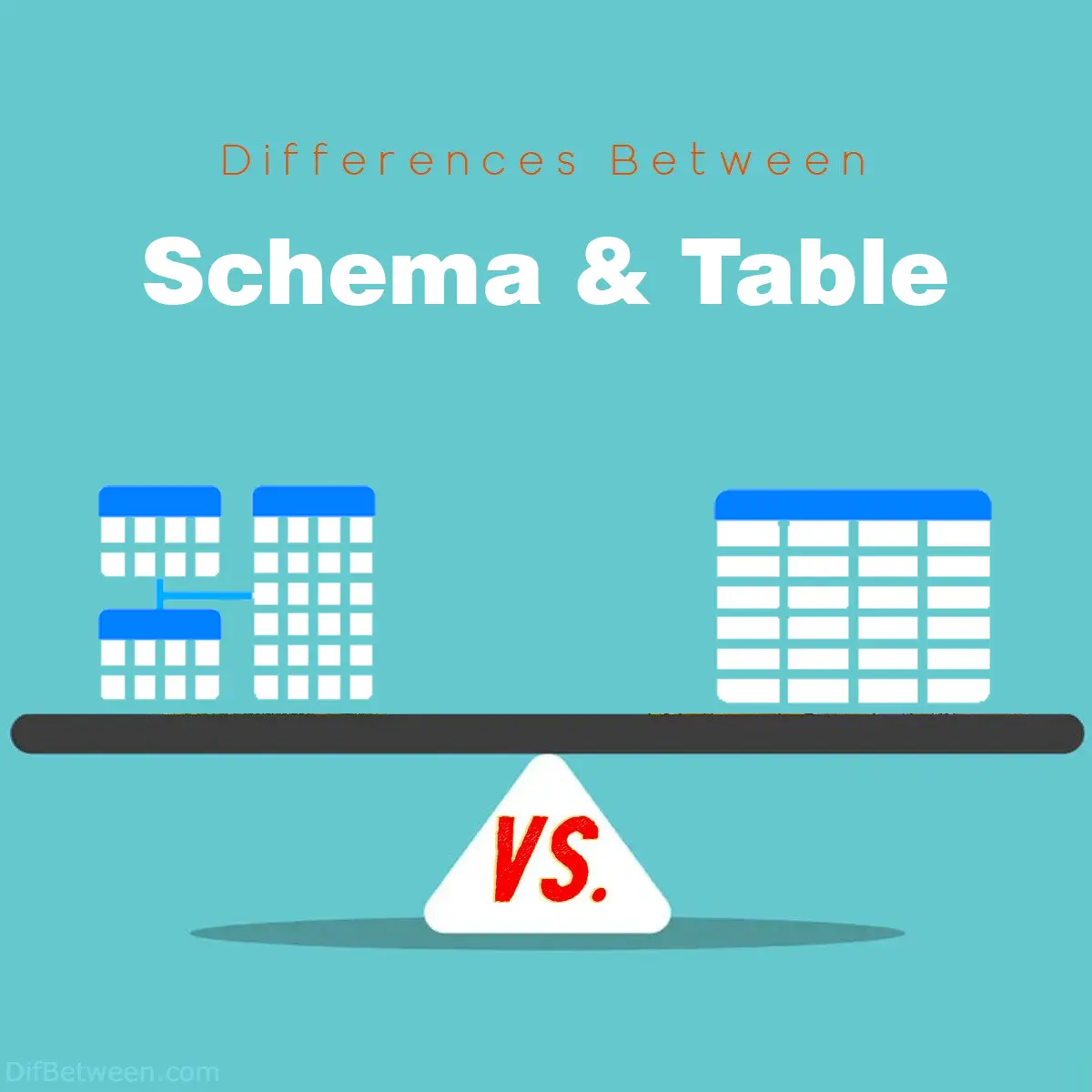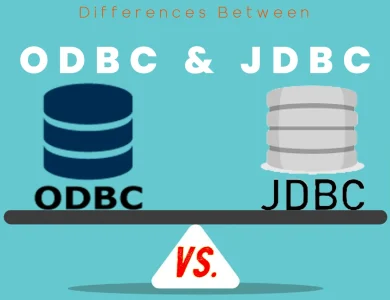
| Aspect | Schema | Table |
|---|---|---|
| Definition | Blueprint or structure of the database. | Physical storage container for data. |
| Purpose | Defines organization, relationships, and constraints of data. | Stores actual data with attributes and values. |
| Structure | High-level design of the database. | Detailed arrangement of rows and columns. |
| Flexibility | Less flexible; changes can be complex and resource-intensive. | More flexible; allows easy data manipulation. |
| Relationships | Establishes relationships between entities. | Holds data and maintains relationships. |
| Granularity | Higher level of abstraction. | Granular representation of individual records. |
| Data Integrity | Enforces constraints for data accuracy. | Abides by schema constraints for data accuracy. |
| Security | Defines access privileges and permissions. | Implements access control at the table level. |
| Normalization | Contributes to database normalization. | Organized storage for normalized data. |
| Data Aggregation | Shapes data aggregation and reporting. | Provides data for aggregation and analysis. |
| Versioning | Manages schema changes and versions. | Handles historical data or versioning. |
| Interoperability | Ensures data standardization and sharing. | Holds standardized data for exchange. |
| Querying and Performance | Guides complex queries and optimizations. | Indexed for efficient data retrieval. |
In this discourse, we shall unravel the intricate tapestry of differences between two fundamental concepts: Schema and Table. Just as a skilled weaver uses different threads to create a masterpiece, so too does the realm of databases employ these entities to craft and organize data. So, let us embark on this expedition of knowledge and discovery!
Differences Between Schema vs Table
The main differences between schema and table in a database lie in their roles and functions. A schema functions as a blueprint, outlining the database’s structure, relationships, and constraints. It defines data types, rules for data integrity, and access privileges. In contrast, a table serves as a container for storing actual data in a structured format, organizing it into rows and columns. While schemas ensure data accuracy and consistency, tables offer flexibility for dynamic data manipulation. Essentially, schemas guide the database’s design, while tables house the tangible data, each playing a distinct role in efficient data management and retrieval.
Defining Schema and Table
Schema: At the heart of every database lies its schema, akin to the blueprint of a grand architectural marvel. A schema is a structural representation, a predefined framework that outlines the organization, relationships, and constraints of data within the database. It serves as the foundation upon which the database is built, defining the data types, fields, and their interconnections.
Table: Imagine a table as a compartment within a library, holding specific volumes of information. A table is a core component of a relational database, where data is stored in rows and columns. It resembles a spreadsheet, with each column representing a different attribute and each row containing a unique record. Tables are the actual containers of data, living within the broader framework of a schema.
Purpose and Function
Schema: Just as the blueprint guides the construction of a building, a schema guides the architecture of a database. It encapsulates the logical structure, relationships, and constraints of the data. A schema defines the entities present in the database, their attributes, and the manner in which they relate to each other. It’s like the master plan that ensures data integrity, consistency, and organization.
Table: Tables are where the actual data resides. They are akin to the shelves in our library analogy, holding the books of information. Each table stores specific types of data, and every row in a table corresponds to a unique record. Tables allow us to organize data into manageable units and enable efficient querying and manipulation.
Structure and Organization
Schema: When it comes to the structure, a schema is concerned with the big picture. It defines the overall design of the database, including its various entities and their relationships. A schema can encompass multiple tables, views, procedures, and other database objects. It ensures that the data is stored logically and meaningfully, maintaining the integrity of the information.
Table: Tables, on the other hand, delve into the finer details. They house the actual data in a tabular format, with columns representing attributes and rows containing individual records. Each table has a specific purpose, such as storing customer details or product information. The organization within a table is straightforward, resembling a well-organized spreadsheet.
Flexibility and Evolution
Schema: Flexibility isn’t the forte of schemas. Once a schema is designed and implemented, altering it can be a complex and resource-intensive task. Changes to a schema often require careful planning, migration strategies, and potential downtime. Schemas are meant to provide stability and structure to the database, so changes are not undertaken lightly.
Table: Tables, in contrast, offer more room for flexibility. Adding, modifying, or deleting records within a table is a common operation that doesn’t typically disrupt the entire system. Businesses often need to adapt to evolving data needs, and tables allow them to do so more easily. For instance, adding a new product to a product catalog table is a relatively simple task.
Relationships and Dependencies
Schema: Relationships are the threads that interconnect the entities within a schema’s tapestry. Schemas define these relationships, specifying how different tables are linked. A schema might establish one-to-many, many-to-one, or many-to-many relationships between tables. This is crucial for maintaining data integrity and ensuring accurate information retrieval.
Table: While tables house the data, they also hold the responsibility of maintaining relationships. Relationships are established through keys—often primary keys and foreign keys—stored within the tables. These keys create links between records across different tables, forming a web of interconnected information.
Granularity and Abstraction
Schema: Schemas operate at a higher level of abstraction. They define the structure and organization of the entire database, encapsulating the essence of its various components. A schema is concerned with the big picture, ensuring that the right tables are in place to support the intended functionality.
Table: Tables are where the rubber meets the road, so to speak. They are the embodiment of real data, storing information about specific entities. Unlike schemas, tables focus on the granular details, housing individual records with their attributes and values.
Querying and Performance
Schema: Querying often involves multiple tables and their relationships. Schemas provide the framework for constructing complex queries that fetch data from various tables. The efficiency of queries depends on the schema design, indexing strategies, and the optimization of relationships.
Table: When it comes to performance, individual tables play a significant role. Proper indexing of tables can greatly enhance query speed, allowing for swift data retrieval. Efficiently designed tables, with appropriate data types and indexing, contribute to the overall performance of the database.
Data Integrity and Constraints
Schema: Data integrity is a cornerstone of any robust database system. Schemas enforce data integrity by allowing the definition of constraints. These constraints can include rules like data types, nullability, uniqueness, and more. Schemas ensure that the data entered into tables adheres to these constraints, maintaining the accuracy and reliability of the information.
Table: While schemas define constraints, tables are where these constraints are put into action. Each table adheres to the constraints set by the schema, ensuring that data is entered in a consistent and reliable manner. For instance, a schema might define that a “birthdate” column cannot contain null values, and tables based on this schema will follow this rule.
Data Definition vs. Data Storage
Schema: A schema focuses on the data’s structure and definition rather than its actual storage. It’s like the blueprint that outlines the rooms and hallways of a building. Schemas specify what types of data will be stored, what relationships they will have, and what rules they must adhere to.
Table: Tables, on the other hand, are where the data is physically stored. They are like the rooms in the building, each containing specific items. Tables contain the actual rows of data with their corresponding values. While schemas provide the blueprint, tables are where the data truly resides.
Security and Access Control
Schema: Security measures are often implemented at the schema level to control access to various parts of the database. Schemas allow for the definition of access privileges and permissions. This means that different users or roles might have different levels of access to different schemas, helping to maintain data confidentiality and integrity.
Table: Within the framework of a schema, individual tables can also have specific access controls. This means that even within a schema that a user has access to, they might only have permission to interact with certain tables. Tables allow for fine-grained access control, ensuring that sensitive data is only accessible to authorized users.
Normalization and Efficiency
Schema: Schemas play a role in the process of database normalization, which is a technique used to minimize data redundancy and improve data integrity. By defining appropriate relationships and dependencies, schemas can contribute to a normalized database design.
Table: Normalization often translates into the organization of data within tables. Tables that are properly normalized contain the necessary fields without redundant information. This not only improves data integrity but also contributes to efficient storage and retrieval of data.
Data Aggregation and Reporting
Schema: Schemas lay the foundation for data aggregation and reporting. They determine how different tables are related and can be joined to retrieve meaningful information. Aggregations, such as calculating sums or averages, often involve data from multiple tables as defined by the schema.
Table: The data required for aggregations and reporting resides within tables. When crafting reports or performing analytics, it’s the data stored in tables that is extracted, manipulated, and aggregated according to the schema’s design.
Versioning and Evolution
Schema: As databases evolve over time, schema changes might be necessary to accommodate new requirements. Schema versioning involves managing different versions of the schema to ensure compatibility and a smooth transition when changes are implemented.
Table: Table data can also have versions, but these are often managed differently. For example, historical data might be stored in separate tables or with timestamps to track changes over time. While schema versioning is concerned with the structure, table data versioning deals with the content and history of data.
Interoperability and Standards
Schema: Schemas are integral in establishing interoperability and adhering to data standards. When different systems or applications need to communicate and share data, having a common schema helps ensure that data can be accurately interpreted and used.
Table: While schemas facilitate interoperability, it’s the actual data within tables that is exchanged and shared. Tables hold the data that needs to be standardized and structured according to the schema’s specifications.
Schema or Table : Which One is Right Choose for You?
In the realm of databases, choosing between schema and table depends on the goals, requirements, and nature of your data management. Each plays a distinct role in shaping the database landscape, and understanding their strengths will guide you towards making the right choice for your specific use case.
When to Choose Schema
- Optimal Data Organization: If your primary concern is defining a logical structure for your database, a schema is your go-to choice. Schemas excel in outlining the blueprint of your data landscape, setting the stage for efficient data management and retrieval.
- Data Integrity is Paramount: If maintaining the accuracy and consistency of your data is crucial, schemas offer a robust mechanism for enforcing constraints. By defining data types, relationships, and constraints, schemas ensure that the data stored adheres to predefined rules, bolstering data integrity.
- Data Sharing and Interoperability: Schemas shine when it comes to data standardization and sharing. If you anticipate the need to exchange data with other systems or applications, a common schema acts as a lingua franca, facilitating smooth data communication.
When to Choose Table
- Flexible Data Manipulation: If your focus is on accommodating dynamic data changes and alterations, tables provide the flexibility you need. Adding, modifying, or deleting records within a table is relatively straightforward, making tables a solid choice for evolving data needs.
- Granular Data Management: If dealing with individual records and attributes is your priority, tables are your allies. Tables are where the rubber meets the road, offering a fine-grained approach to data storage and retrieval.
- Efficient Queries and Reporting: If your primary use case involves data analysis, reporting, and querying, tables can be optimized to enhance performance. Proper indexing and data organization within tables lead to faster and more efficient data retrieval.
Making the Right Choice
The decision between schema and table ultimately hinges on your specific objectives and the nature of your data ecosystem. Often, these two entities work in harmony, with the schema providing the overarching structure and relationships, while tables house the tangible data.
Consider the following questions when making your choice:
- What’s Your Priority: Is your focus on establishing a solid structure or on efficiently storing and retrieving data?
- Data Evolution: Will your data evolve frequently, requiring dynamic changes, or will it remain relatively stable?
- Data Relationships: Do you need to establish complex relationships between different entities?
- Data Integrity: How critical is maintaining data accuracy and adherence to rules?
- Data Sharing: Will your data need to be shared with external systems or applications?
- Query Performance: Do you anticipate frequent data analysis and reporting needs?
Remember that a successful data management strategy often involves both schemas and tables working together, each contributing its unique strengths to the database ecosystem. Whether you opt for the strategic framework of a schema or the pragmatic storage of tables, your choice should align with your data’s story and the narrative you wish to craft.
FAQs
A schema defines the overall structure, relationships, and constraints of a database, serving as a blueprint. A table, on the other hand, is a physical storage container within a schema that holds the actual data in rows and columns.
Schemas enforce data integrity by setting rules and constraints for the data stored in tables. They define data types, nullability, uniqueness, and relationships, ensuring that the data remains accurate and consistent.
Data normalization is a process that minimizes data redundancy and improves integrity. Schemas contribute to normalization by defining relationships and dependencies between tables. Tables, then, hold normalized data by reducing duplication and ensuring efficient storage.
Tables offer more flexibility compared to schemas. You can easily add, modify, or delete records within a table. Schemas, however, are less flexible as changes to them often require careful planning and sometimes complex alterations.
Schemas ensure data standardization, making it easier to share data with external systems or applications. A common schema allows different systems to interpret and use data accurately.
Efficiently designed tables, with proper indexing, enhance query performance by enabling faster data retrieval. When it comes to reporting and analysis, tables provide the data required for aggregation and generating insights.
Schema versioning involves managing different versions of the schema to accommodate changes over time. Table data versioning, on the other hand, often involves storing historical data or managing different versions of records within a table.
Both schema and table are essential components of a well-designed database. Schemas provide the framework and structure, while tables store and manage the actual data. The choice depends on your specific data management needs and goals.
Schemas provide the overarching structure, relationships, and constraints for the database. Tables live within schemas and house the data. The schema defines the rules and organization, while the tables hold and manage the tangible information.
It’s not an either-or choice. Schemas and tables are complementary. Schemas provide the logical framework and constraints, while tables store the data according to that framework. In a well-designed database, they work together harmoniously to ensure effective data management.
Read More :
Contents
- Differences Between Schema vs Table
- Defining Schema and Table
- Purpose and Function
- Structure and Organization
- Flexibility and Evolution
- Relationships and Dependencies
- Granularity and Abstraction
- Querying and Performance
- Data Integrity and Constraints
- Data Definition vs. Data Storage
- Security and Access Control
- Normalization and Efficiency
- Data Aggregation and Reporting
- Versioning and Evolution
- Interoperability and Standards
- Schema or Table : Which One is Right Choose for You?
- FAQs






